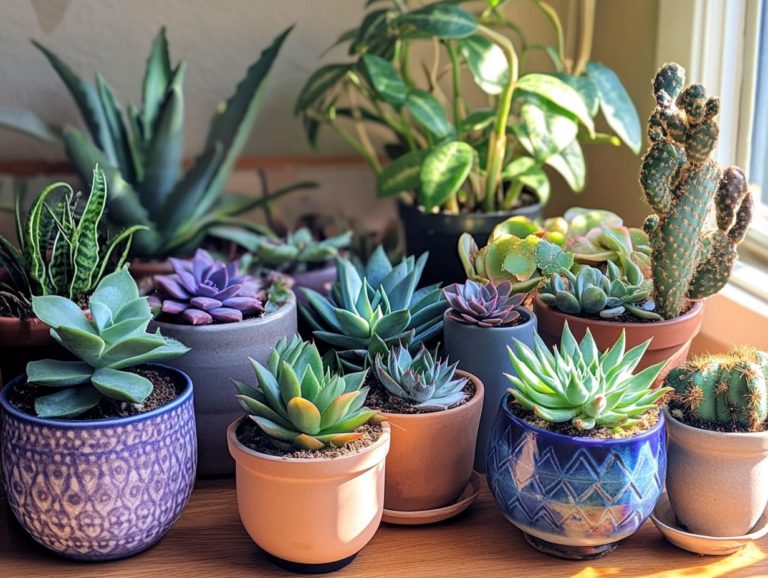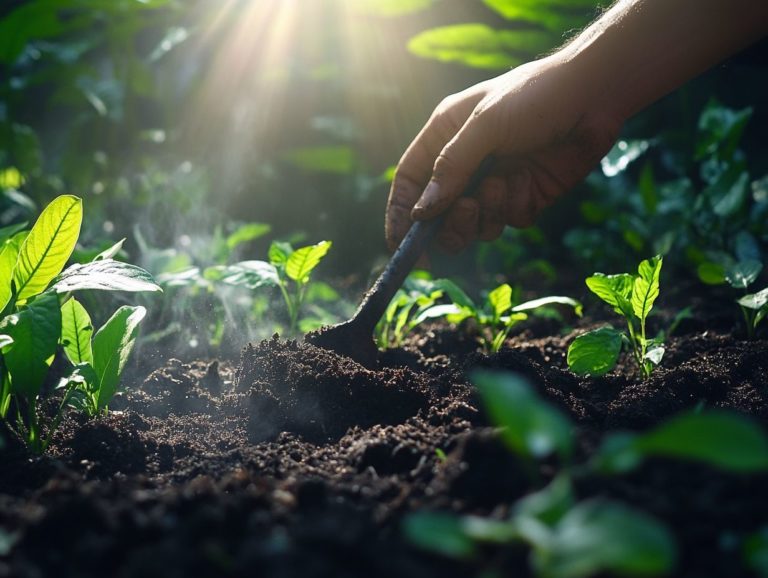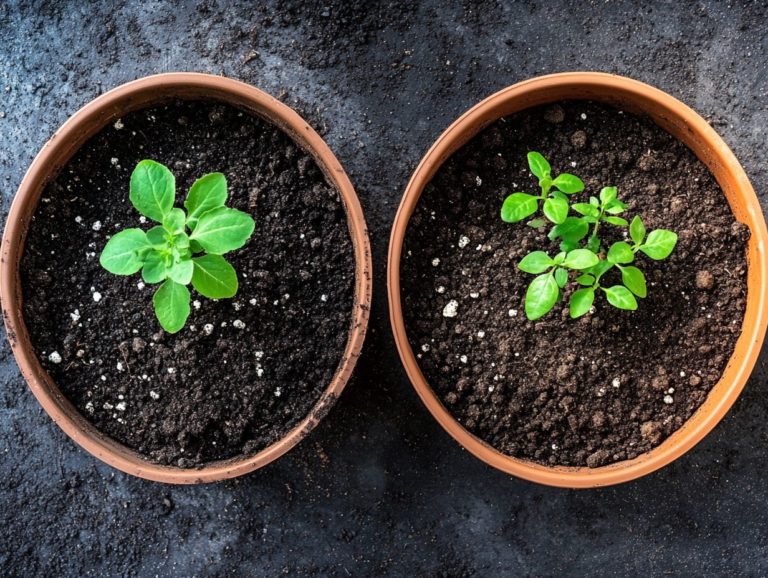Best Indoor Plant Potting Mix: A Quick Guide
Choosing the right potting mix is essential for the thriving success of your indoor plants.
With countless options at your disposal, grasping the nuances of potting mix, its benefits, and how to select the ideal one can seem daunting. This guide will walk you through the essentials of potting mixes, highlighting the distinctions between organic and inorganic types, as well as specialty mixes designed for specific plants.
You ll also discover DIY recipes for crafting your own mix and valuable tips for maintaining it. Prepare to nurture your indoor garden with confidence and expertise!
Contents
- Key Takeaways:
- Understanding Potting Mixes
- Choosing the Right Potting Mix
- Types of Potting Mixes
- Making Your Own Potting Mix
- Maintaining Your Potting Mix
- Frequently Asked Questions on Plant Care
- What is the best type of potting mix for indoor plants?
- How often should I repot my indoor plants?
- Can I make my own indoor plant potting mix?
- Why is good drainage important in an indoor plant potting mix?
- What are the signs that my indoor plant needs to be repotted?
- Can I reuse potting mix from previous plantings?
Key Takeaways:
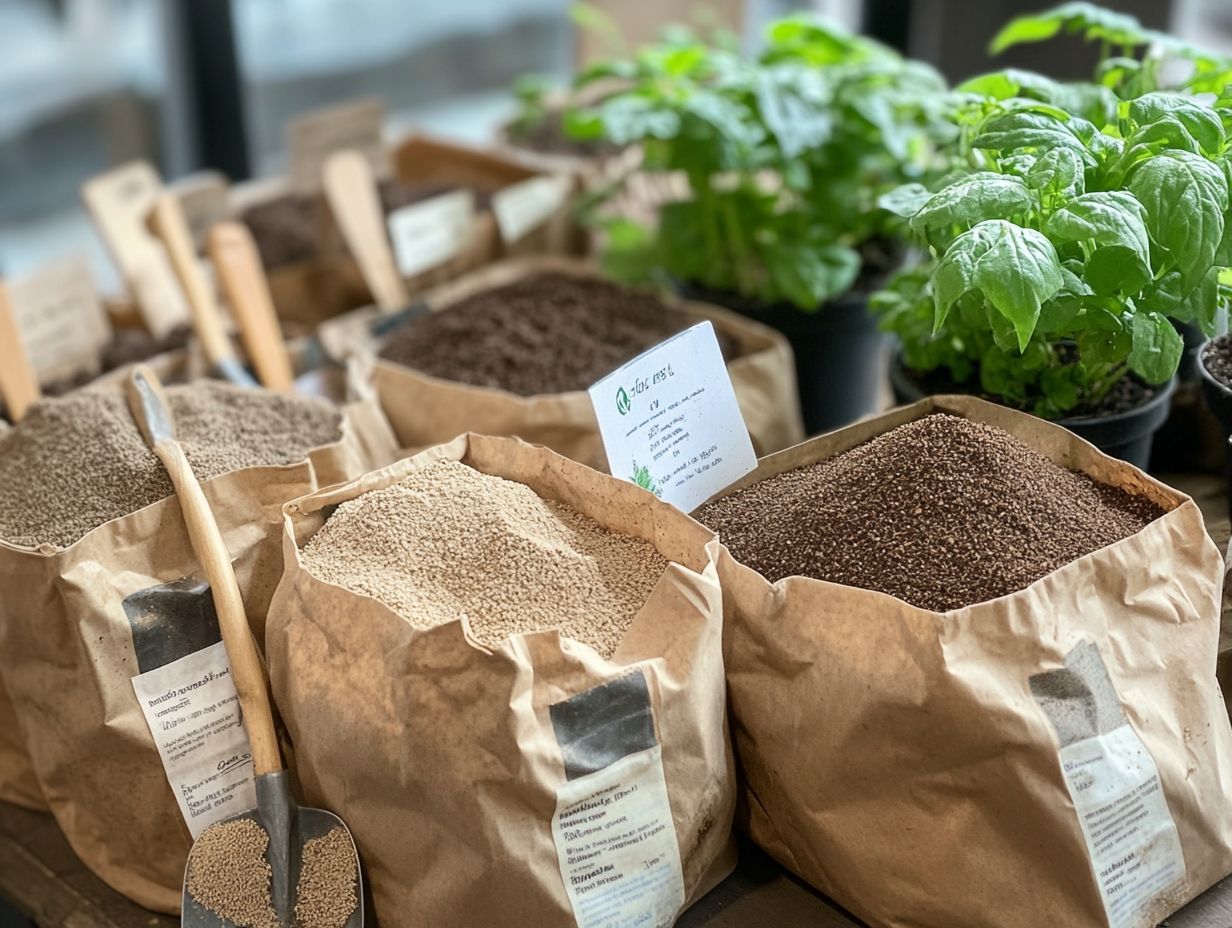
- Potting mixes provide many benefits for indoor plants, such as improved drainage, aeration, and essential nutrients.
- The right potting mix should be chosen based on factors like plant type, environmental conditions, and personal preferences.
- For those who prefer a hands-on approach, making your own potting mix can be a cost-effective and customizable option.
Understanding Potting Mixes
Understanding potting mixes is crucial for anyone engaged in indoor gardening. The right potting soil can profoundly affect the growth and health of your indoor plants.
A premium-quality potting mix delivers essential nutrients and guarantees proper drainage and aeration, both vital for nurturing a thriving root system. By incorporating organic components like coco coir and peat moss, you can enhance moisture retention.
The right soil amendments, such as perlite and vermiculite, significantly improve soil structure and airflow, allowing for optimal plant care and flourishing growth.
What is a Potting Mix?
A potting mix is your secret weapon for creating the perfect environment for indoor plants. It is meticulously crafted to ensure plants flourish in containers. This blend is not just any old soil; it s a combination of components designed to provide optimal nutrients and support.
In your potting mix, you’ll find a variety of organic materials that work together harmoniously to foster growth. Peat moss, with its exceptional moisture-retaining qualities, keeps your plants hydrated, while coco coir enhances aeration and drainage, safeguarding against root rot (a condition where roots decay due to excess moisture).
Components like perlite or vermiculite might also be added for an extra boost in drainage, ensuring that your plants’ roots stay healthy and never waterlogged. This thoughtfully balanced mix allows your plants to absorb essential nutrients, promoting robust root development crucial for their overall growth and vitality.
Benefits of Using a Potting Mix
A great potting mix can supercharge your indoor garden! It offers many benefits that elevate the growth and sustainability of your indoor plants. With improved drainage, enhanced airflow, and optimal moisture retention, this mix is essential for nurturing a robust root system.
A quality potting mix is meticulously crafted to strike the perfect balance among these elements, ensuring your plants receive just the right amount of water without succumbing to waterlogging (when excess water causes roots to suffocate). By incorporating materials that help excess water escape, like perlite or vermiculite, you can effectively prevent root rot while still retaining sufficient moisture to meet your plants’ needs.
The structure of the mix promotes exceptional airflow, vital for root respiration (the process by which roots take in oxygen). Healthy roots thrive in an oxygen-rich environment, stimulating growth and enhancing nutrient uptake. Moisture retention plays a crucial role as well; it helps buffer against fluctuations in watering schedules, thereby shielding your plants from stress.
Collectively, these elements create a thriving ecosystem, fostering robust growth and resilience in your indoor garden.
Choosing the Right Potting Mix
Selecting the ideal potting mix for your indoor plants is essential for ensuring their health and growth. Consider how factors like soil composition, watering preferences, and the unique requirements of your plants influence the best soil options available.
This thoughtful approach will elevate your plant care to new heights, fostering thriving greenery in your space.
Start your indoor gardening journey today with the right potting mix!
Factors to Consider

When you re choosing a potting mix, there are several essential factors to consider, such as the specific needs of your indoor plants, their nutrient requirements, and whether they prefer moisture-rich or drier conditions.
Different types of plants have their own distinct preferences. For instance, orchids thrive in a well-draining mix that includes materials like bark or perlite, which allow for proper aeration and help prevent root rot. On the other hand, succulents require a more granular blend that ensures efficient drainage while still supplying the necessary nutrients. To learn more about ensuring optimal growth, check out the best practices for indoor plant soil care.
Understanding soil structure is crucial; it directly impacts moisture retention and airflow, both vital for robust root development.
Adding organic matter can elevate your potting mixes, catering to various plant needs and fostering lush, vibrant growth.
Types of Potting Mixes
Grasping the various types of potting mixes available is essential for you as an indoor gardener. These mixes can be primarily divided into organic and inorganic options, each presenting distinct advantages specifically suited to different plant types and growing conditions.
Organic vs. Inorganic
Organic potting mixes typically include natural materials like peat moss, coco coir, and compost. They create rich soil for your plants. In contrast, inorganic mixes often feature materials such as perlite and vermiculite, which excel in drainage but may need some extra amendments to keep your plants in top shape.
Organic options help retain moisture and nurture beneficial microbial life, making them a go-to for those who prefer a sustainable gardening approach.
Inorganic mixes shine when it comes to plants that thrive in drier conditions or are more prone to root rot. They enhance aeration and prevent compaction.
Each type of mix caters to specific plant needs; for instance, succulents and cacti thrive in inorganic blends, while leafy greens and flowering plants typically flourish in the rich nutrients of organic mixes. By understanding these characteristics, you can tailor your potting choices to create the perfect environment for your plants to grow and thrive. Consider exploring DIY potting mix recipes for indoor plants to enhance your gardening experience.
Specialty Mixes for Different Plants
Specialty potting mixes are crafted specifically for different plant types. For instance, cacti and succulents flourish in sandy, well-draining soils, while tropical plants thrive on moisture-retentive blends enriched with soil amendments such as orchid bark.
Take orchids, for example their unique mix often features fir bark and perlite. This ensures necessary aeration and drainage to prevent root rot, which can be quite detrimental to these delicate beauties.
Carnivorous plants, on the other hand, require a different strategy. They tend to thrive in mixes that incorporate sphagnum moss, a type of moss that holds moisture well, while lightly acidic components help mimic their native habitats.
By grasping the specific nutritional and structural needs of each plant type, you can thoughtfully select or even create the ideal potting mix, setting the stage for vibrant growth and robust health in both your indoor and outdoor gardens.
Making Your Own Potting Mix
Crafting your own potting mix is a fun way to tailor the perfect environment for your plants! You can blend components such as compost, soil amendments, and organic materials to craft an aerated soil mixture.
This thoughtful combination not only enhances moisture retention but also supports a robust and healthy root system, ensuring your plants thrive in their environment.
Don t wait! Start blending your custom mix today for thriving plants!
DIY Recipes and Tips
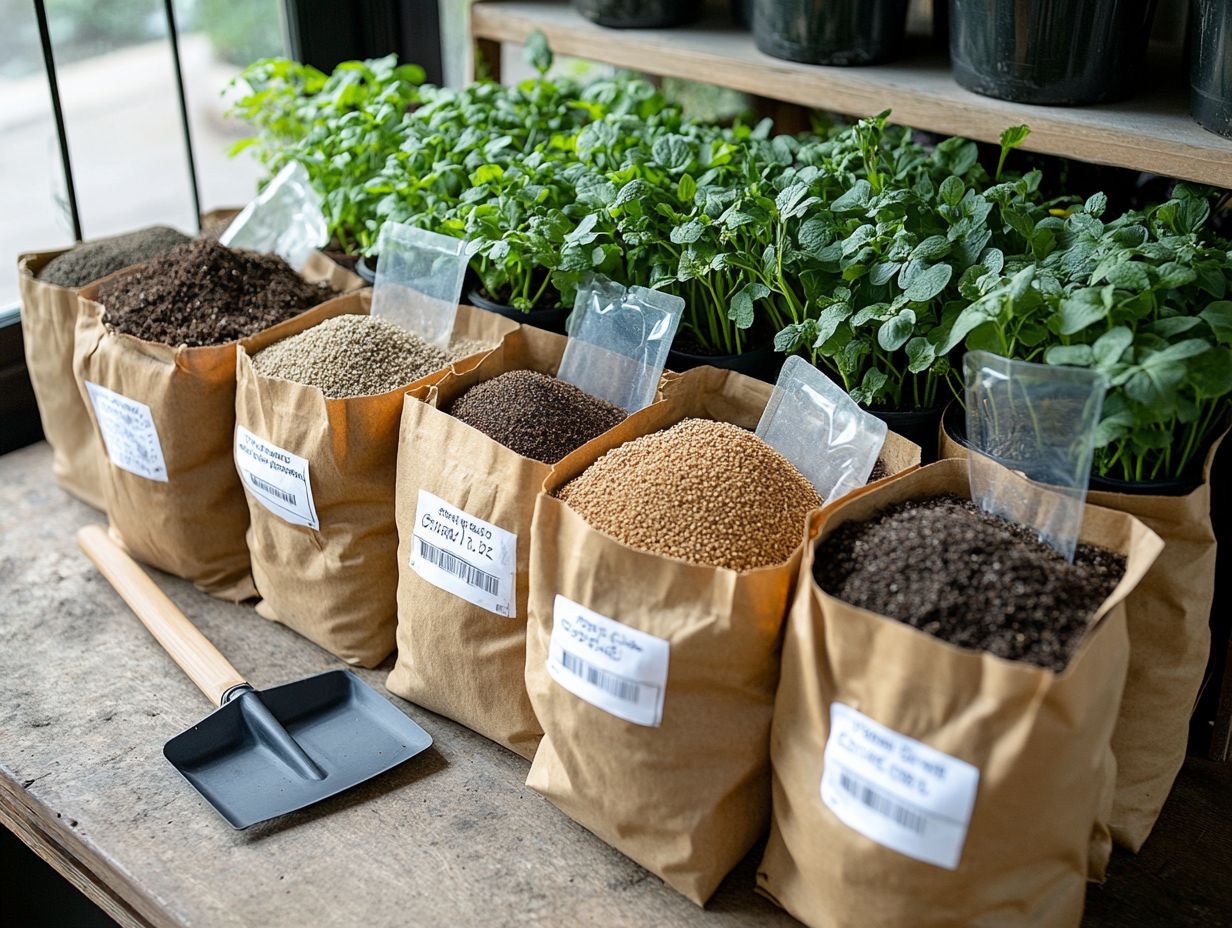
When crafting your own potting mix, blend ingredients like coco coir, peat moss, and perlite. Also, consider adding some soil amendments for the perfect texture and moisture retention tailored to your specific plants.
This custom blend promotes healthy root growth and enhances aeration and drainage both crucial for preventing the dreaded overwatering.
For your succulent and cactus varieties, use a mix of:
- 50% coarse sand
- 30% perlite
- 20% coco coir
This combination ensures optimal drainage, allowing these plants to thrive in drier conditions.
For leafy greens and indoor herbs, a richer mix is key. Combine equal parts of peat moss and compost, adding a touch of perlite for good measure. This will supply essential nutrients while keeping moisture in check.
By adjusting your potting mix to meet each plant’s unique requirements, you ll cultivate flourishing greenery that showcases your gardening prowess.
Maintaining Your Potting Mix
Maintaining your potting mix is essential for keeping your indoor plants healthy and thriving. Consistent care and replenishment of nutrients are necessary, along with adjustments based on your plants’ watering preferences and the environmental conditions they face.
Proper Care and Replenishment of Indoor Plants
Proper care and timely replenishment of your potting mix are vital for sustaining nutrient-rich soil and supporting optimal plant health. This ensures your indoor plants receive the necessary elements for robust growth.
This simple practice supercharges your soil s fertility and contributes to a balanced ecosystem that fosters thriving plants. Act quickly if you notice a decline in your plants’ vigor or see yellowing leaves; it s time to assess the health of your potting mix.
Regularly check your moisture levels to prevent both under and overwatering, which can lead to root rot or other complications.
Implementing techniques like adding compost or worm castings as natural fertilizers can significantly boost nutrient levels. Rotate your plants to create a healthier environment for their growth.
Frequently Asked Questions on Plant Care
What is the best type of potting mix for indoor plants?
The best type of potting mix for indoor plants is one specifically formulated for them. These mixes typically have a blend of peat moss, perlite, and vermiculite to provide a balance of moisture retention and aeration.
How often should I repot my indoor plants?
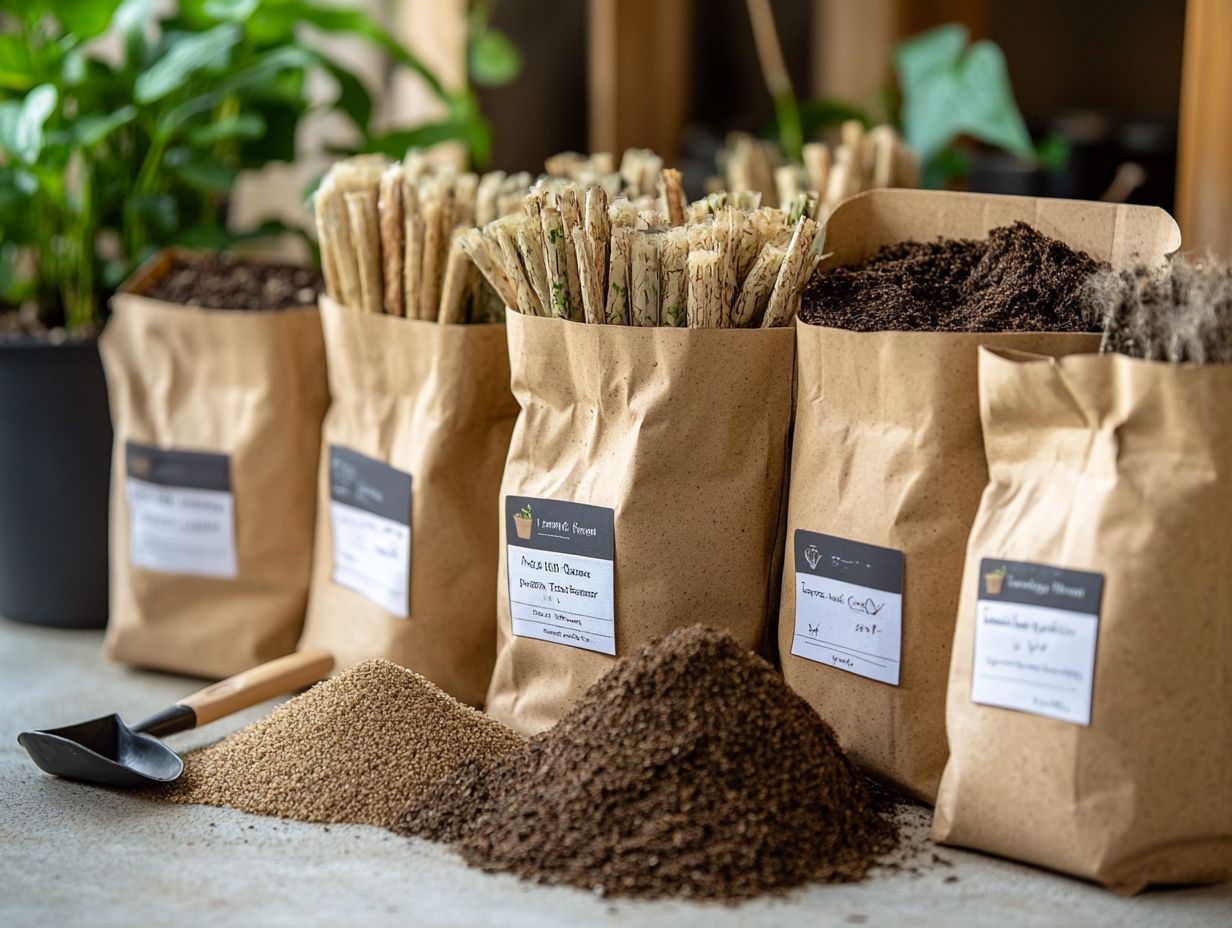
The frequency of repotting depends on the pot size and the plant s growth rate. As a general rule, repot your plants every 1-2 years to ensure they have enough room to grow and receive fresh nutrients from the potting mix.
Can I make my own indoor plant potting mix?
Yes, you can make your own indoor plant potting mix. A simple recipe includes equal parts of peat moss, perlite, and compost. Ensure the mix is well-draining and provides enough nutrients for the plant.
Why is good drainage important in an indoor plant potting mix?
Good drainage is crucial as it allows excess water to escape, preventing the roots from becoming waterlogged. This helps to prevent root rot and other fungal diseases.
What are the signs that my indoor plant needs to be repotted?
If your indoor plant shows stunted growth, yellowing leaves, or roots growing out of the drainage holes, it may be time to repot. Quick action is necessary if the potting mix dries out rapidly or becomes waterlogged; this indicates that the plant may need a larger pot.
Can I reuse potting mix from previous plantings?
Yes, you can reuse potting mix from previous plantings. However, it s important to refresh the mix before using it again. Add fresh compost, perlite, and other amendments to replenish the nutrients and improve the texture of the mix.
Get started today with your potting mix!

